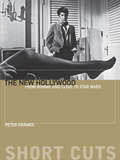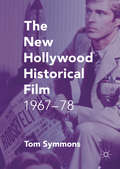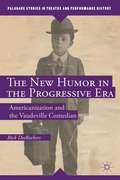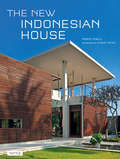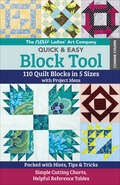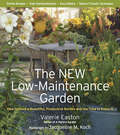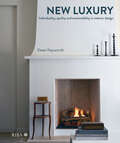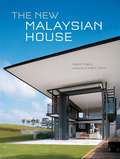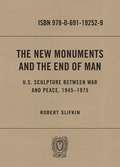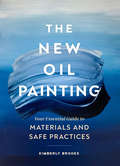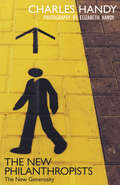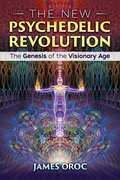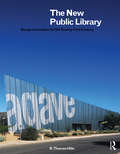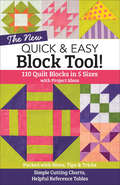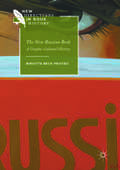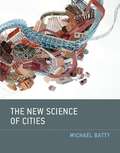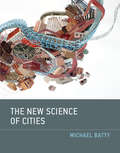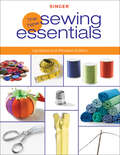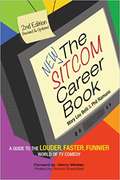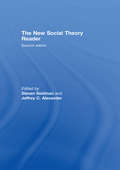- Table View
- List View
The New Hollywood
by Peter KramerOn December 8, 1967 Time magazine put Bonnie and Clyde on its cover and announced, "The New Cinema: Violence ... Sex ... Art." The following decade has long been celebrated as a golden age in American film history. In this innovative study, Peter Krämer offers a systematic discussion of the biggest hits of the period (including The Graduate [1967], The Exorcist [1973] and Jaws [1975]). He relates the distinctive features of these hits to changes in the film industry, in its audiences and in American society at large.
The New Hollywood Historical Film
by Tom SymmonsThe New Hollywood of the late 1960s and 1970s is among the mostinfluential periods in the history of film. It was a time of unprecedentedcreative risks, as the myths and moral certainties of 'old Hollywood' collidedwith the subversive and questioning stance of a new wave of young and talentedpractitioners. As the fault lines of the Vietnam War, Civil Rights Movement andthe Watergate scandal shook America to its core; films expressed a profoundsense of uncertainty, change and possibility. Longone of Hollywood's most popular genres, a new wave of historical films thrivedin the era of New Hollywood. The New Hollywood Historical Film: 1967-78explores new directions and perspectives considering iconic films; American Graffiti (1973), The Dirty Dozen (1967), Grease (1978) and The Way We Were (1973), as well as lesser known gems, such as Sounder (1973) and The Day of the Locust (1975). Based on original research, TomSymmons analyses their production and reception, examining how the pastdepicted on film was profoundly shaped by the controversies and concerns of thepresent.
The New Hollywood: From Bonnie and Clyde to Star Wars (Short Cuts)
by Peter KrämerOn December 8, 1967 Time magazine put Bonnie and Clyde on its cover and announced, "The New Cinema: Violence ... Sex ... Art." The following decade has long been celebrated as a golden age in American film history. In this innovative study, Peter Krämer offers a systematic discussion of the biggest hits of the period (including The Graduate [1967], The Exorcist [1973] and Jaws [1975]). He relates the distinctive features of these hits to changes in the film industry, in its audiences and in American society at large.
The New Humor in the Progressive Era
by Rick DesrochersBy tracing the effects of unprecedented immigration, the advent of the new woman, and the little-known vaudeville careers of performers like the Elinore Sisters, Buster Keaton, and the Marx Brothers, DesRochers examines the relation between comedic vaudeville acts and progressive reformers as they fought over the new definition of "Americanness. "
The New Indonesian House
by Robert Powell Albert Lim KsThe New Indonesian House presents twenty-eight homes in Jakarta, Bandung, Yogyakarta and Bali that illustrate the remarkable advances that have taken place in residential design in Indonesia over the last two decades. Indonesia's new generation of architects demonstrates not only their Absorption of modern influences from the West and the more recent processes of globalization but also their sensitivity to the physical environment, the social context and the aspirations of the leading elite. With its stunning color photographs, The New Indonesian House will both delight and inspire the application of its exhilarating architectural expressions in any global setting.
The New Indonesian House
by Robert Powell Albert Lim KsThe New Indonesian House presents twenty-eight homes in Jakarta, Bandung, Yogyakarta and Bali that illustrate the remarkable advances that have taken place in residential design in Indonesia over the last two decades. Indonesia's new generation of architects demonstrates not only their Absorption of modern influences from the West and the more recent processes of globalization but also their sensitivity to the physical environment, the social context and the aspirations of the leading elite. With its stunning color photographs, The New Indonesian House will both delight and inspire the application of its exhilarating architectural expressions in any global setting.
The New Ladies' Art Company Quick & Easy Block Tool: 110 Quilt Blocks in 5 Sizes with Project Ideas
by Connie ChunThe ultimate no-math reference for quilters with cutting instructions at your fingertips, plus exploded construction schematics to make sewing easier. Now in an easy-to-use reference guide size, this updated block tool includes 110 authentic blocks from America&’s first mail-order pattern company, the Ladies&’ Art Company. Each block has instructions for five sizes, design details, construction diagrams, inspiration blocks, and even a project! The projects will be a breeze with helpful design hints specific to each block, including pairing them with plain alternate blocks, creating secondary patterns, and using precuts. Make the blocks your own with line drawings ready to fill in with your own colors, plus values-only blocks to spur your creativity, then fly through construction with easy rotary-cutting charts, yardage requirements, diagonal measurements, and more.
The New Low-Maintenance Garden: How to Have a Beautiful, Productive Garden and the Time to Enjoy It
by Valerie Easton Jacqueline Knox Jacqueline M. KochDo you ever lament that you'd love to be able to garden more, but just don't have the time? The demanding pace of modern life leaves little space for the pleasures of gardening. On the other hand, gardening itself could be the culprit: elaborate, traditional perennial borders; water-hungry or disease-prone plants; needy lawns; and high-maintenance plants that require staking or clipping all suck up precious hours. Simply put, we need to start gardening in a whole new way. In this inspiring book, Val Easton shows exactly how to have a low-maintenance garden that doesn't sacrifice style. You won't have to give up your favorite plants or settle for expanses of ugly bark nuggets. You just have to unlearn some bad old habits and pick up some good new ones. So, how do you go about making a "new" low-maintenance garden? First, design your garden with maintenance in mind—good-looking hardscape will both save weeding time and showcase your favorite plants. Second, simplify your garden routines—learn the most efficient planting and maintenance techniques and don't get stressed if everything isn't letter-perfect. Third, learn how to work with nature rather than against it. And finally, embrace home-grown fruits, herbs, and vegetables; well planted containers; and thoughtfully chosen plants.The New Low-Maintenance Garden doesn't just tell you how to garden in a whole new way—it shows you, through profiles and beautiful photographs of real gardens that embody low-maintenance techniques. The pressures of life are not likely to ease up anytime soon, but the lessons of this timely book will help you banish guilt over undone garden chores and revel in your garden successes.
The New Luxury: Individuality, quality and sustainability in interior design
by Dean KeyworthThis book explores what 'luxury' in interior design means today and how to achieve it, and provides inspirational examples of projects from a range of designers that meet the parameters of quiet luxury. Like many other sectors, interior design can be polarised: the luxury, unattainable end, and the cheap and cheerful lower end.This book disregards this dichotomy and shows how designers can avoid a throw-away culture, cleaving to that idea of longevity and high-quality above the cheap and flimsy, even for those with smaller budgets. Illustrated with beautiful examples of projects, this is a book that showcases how interior designers and homeowners alike can achieve an interior space that prioritises quality and sustainability on every kind of budget, focusing on quality fabrics and materials, sustainable credentials and complementary tones.
The New Malaysian House
by Robert Powell Albert Lim KsThe New Malaysian House is a collection of 25 contemporary houses that demonstrate a remarkable flowering of Malaysian design talent that has been germinating since the mid- 1980s. The houses range from luxury detached bungalows set in extensive tropical gardens to weekend retreats in the forest, from the gated communities springing up throughout Malaysia to extended family homes. All are distinguished by a singular quality of innovative design as the architects sought to explore new approaches for designing with the climate and in the cultural context of Malaysia.
The New Malaysian House
by Robert Powell Albert Lim KsThe New Malaysian House is a collection of 25 contemporary houses that demonstrate a remarkable flowering of Malaysian design talent that has been germinating since the mid- 1980s. The houses range from luxury detached bungalows set in extensive tropical gardens to weekend retreats in the forest, from the gated communities springing up throughout Malaysia to extended family homes. All are distinguished by a singular quality of innovative design as the architects sought to explore new approaches for designing with the climate and in the cultural context of Malaysia.
The New Middle Ages
by Jerold C. FrakesBroadens the perspective of recent work on the discourse of the Muslim Other in medieval Christendom by investigating pertinent texts, art, and artefacts, situating these local discourses of the Muslim Other in the larger cultural context of proto-Eurocentric discourse.
The New Monuments and the End of Man: U.S. Sculpture between War and Peace, 1945–1975
by Robert SlifkinHow leading American artists reflected on the fate of humanity in the nuclear era through monumental sculptureIn the wake of the atomic bombings of Japan in 1945, artists in the United States began to question what it meant to create a work of art in a world where humanity could be rendered extinct by its own hand. The New Monuments and the End of Man examines how some of the most important artists of postwar America revived the neglected tradition of the sculptural monument as a way to grapple with the cultural and existential anxieties surrounding the threat of nuclear annihilation.Robert Slifkin looks at such iconic works as the industrially evocative welded steel sculptures of David Smith, the austere structures of Donald Judd, and the desolate yet picturesque earthworks of Robert Smithson. Transforming how we understand this crucial moment in American art, he traces the intersections of postwar sculptural practice with cybernetic theory, science-fiction cinema and literature, and the political debates surrounding nuclear warfare. Slifkin identifies previously unrecognized affinities of the sculpture of the 1940s and 1950s with the minimalism and land art of the 1960s and 1970s, and acknowledges the important contributions of postwar artists who have been marginalized until now, such as Raoul Hague, Peter Grippe, and Robert Mallary.Strikingly illustrated throughout, The New Monuments and the End of Man spans the decades from Hiroshima to the Fall of Saigon, when the atomic bomb cast its shadow over American art.
The New Museum Registration Methods
by Rebecca A. Buck Jean Allman GilmoreA successor to "Museum Registration Methods" after the revision of its third volume was abandoned as impractical. Reports the most recent research and practice for improving the care, safety, and documentation of museum collections. Covers documentation, collections management, processes, administrative functions, risk management, and ethical and legal issues. Includes a glossary without pronunciation.
The New Oil Painting: Your Essential Guide to Materials and Safe Practices
by Kimberly BrooksHere is everything you need to know about getting into oil painting—and maintaining a safe, solvent-free oil painting practice—in a slim, sophisticated guide.Oil painting is an exciting and adventurous medium, but aspiring artists can feel daunted by complex setups and the thought of using harsh chemicals. All of that changes now. The New Oil Painting walks you step-by-step through oil painting fundamentals—which materials you actually need, how to mix paint, how to set up your painting space—and, most revolutionary of all, how to eliminate harmful solvents from your work and replace them with safe, effective substitutes. This instructional handbook is organized into chapters with helpful diagrams throughout illustrating various techniques and tools. Whether you're a true beginner or have been painting with oils for years, you will find that this book has everything you need to build a new, thriving, toxin-free practice.• UNIQUE APPROACH: Not only does this book help aspiring artists build a repertoire of skills and materials, it also offers all artists, regardless of their experience levels, methods for eliminating solvents and other toxic substances from their oil painting practices. What was once a dangerous pastime is now a guilt-free, health-conscious, and rewarding activity. And using safe, nontoxic materials is better for the environment!• LONG-TERM USE: Good art instruction can deliver over a long period of time, and this handy guide is no exception. Along with being able to use this as an entryway into oil painting, you can also use it for reference or reread sections when you need a brushup.• EXPERT AUTHOR WITH IMPRESSIVE CREDENTIALS: Painter Kimberly Brooks was the founding arts editor at Huffington Post. As a painter, she exhibits her work frequently throughout the United States and was a featured artist with the National Endowment for the Arts. She has led oil painting workshops, and now she shares her vast knowledge of the subject in this accessible and comprehensive handbook.Perfect for:• Artists and art aspirants interested in exploring a new medium• Experienced oil painters looking to eliminate solvents from their practices• Painting students and teachers
The New Philanthropists
by Charles HandyWho are the new philanthropists? And how is their philanthropy 'new'?In this remarkable and inspiring book, the eminent management writer Charles Handy and his wife Elizabeth, a portrait photographer, have collaborated to portray a new generation of practical philanthropists, men and women who have made their own fortunes and decided to move on from financial success to try to help those in need. They are doing so not simply by giving their money away to charities and agencies but by helping actively, working on the spot with the very people who need their aid, ensuring that the initiatives are sustainable in the longer term.As in their acclaimed The New Alchemists, the Handys have both interviewed and photographed their subjects in order to tell their inspiring stories; from the Sydney restaurateur Jeff Gambin, who personally helps to cook hot and cold menus for homeless people; to Niall Mellon, a young Irish property developer who is replacing the shacks with breeze-block homes in a South African township; and Sara Davenport, who sold her art gallery and set up the breast-cancer care centre the Haven Trust to offer integrated and holistic treatment and support. This striking book of words and photographs reveals the energy and inspiration of these new ways of using wealth, revealing the motivations and satisfactions of such direct action.
The New Psychedelic Revolution: The Genesis of the Visionary Age
by James OrocA bold exploration of modern psychedelic culture, its history, and future • Examines 3 modern psy-culture architects: chemist Alexander “Sasha” Shulgin, mycologist-philosopher Terence McKenna, and visionary artist Alex Grey • Investigates the use of microdosing in extreme sports, the psy-trance festival experience, and the relationship between the ego, entheogens, and toxicity • Presents a “History of Visionary Art,” from its roots in prehistory, to Ernst Fuchs and the Vienna School of the Fantastic, to contemporary psychedelic art After the dismantling of a major acid laboratory in 2001 dramatically reduced the world supply of LSD, the psychedelic revolution of the 1960s appeared to have finally run its course. But the opposite has actually proven to be true, and a psychedelic renaissance is rapidly emerging with the rise in popularity of transformational festivals like Burning Man and BOOM!, the return to positive media coverage of the potential benefits of entheogens, and the growing number of celebrities willing to admit the benefits of their own personal use. Along with the return of university research, the revival of psychedelic philosophy, and the increasing popularity of visionary art, these new developments signify the beginning of a worldwide psychedelic cultural revolution more integrated into the mainstream than the counterculture uprising of the 1960s. In his latest book, James Oroc defines the borders of 21st-century psychedelic culture through the influence of its three main architects-- chemist Alexander Shulgin, mycologist Terence McKenna, and visionary artist Alex Grey--before illustrating a number of facets of this “Second Psychedelic Revolution,” including the use of microdosing in extreme sports, the tech-savvy psychedelic community that has arisen around transformational festivals, and the relationship between the ego, entheogens, and toxicity. This volume also presents for the first time a “History of Visionary Art” that explains its importance to the emergence of visionary culture. Exploring the practical role of entheogens in our selfish and fast-paced modern world, the author explains how psychedelics are powerful tools to examine the ego and the shadow via the transpersonal experience. Asserting that a cultural adoption of the entheogenic perspective is the best chance that our society has to survive, he then proposes that our ongoing psychedelic revolution--now a century old since the first synthesis of a psychedelic in 1918--offers the potential for the birth of a new Visionary Age.
The New Public Library: Design Innovation for the Twenty-First Century
by R. Thomas HilleThe New Public Library is an in-depth design study of an exemplary collection of recent public libraries, and the historical precedents that have informed and inspired their development. An introductory overview presents seven critical themes that characterize public library design, past and present, highlighting the expressive architectural potential of this unique and important building type. A survey of over 40 historically significant libraries traces the development of the building type over time, with a primary focus on precedents from the US and northern Europe, where the modern public library originated, and its design has been most comprehensively developed. A selection of nearly 50 contemporary projects from the past 30 years focuses on the most current developments in public library design, with a diverse and varied collection of work by over 35 regional, national, and international design firms. Highly visual in its presentation, the study includes 885 color photographs and illustrations, and 195 scale drawings.
The New Quick & Easy Block Tool!: 110 Quilt Blocks in 5 Sizes with Project Ideas—Packed with Hints, Tips & Tricks
by C&T PublishingThe expanded edition of the ultimate no-math reference guide for quilters—featuring even more blocks, diagrams, and essential tips! Cutting and planning blocks is easier than ever with this convenient guide featuring 110 traditional quilt blocks in 5 sizes each. This guide also has rotary-cutting charts, reference tables, a block index, and dozens of precut-friendly designs. Block diagrams make construction a breeze, while color-filled blocks and blank line drawings spur your creativity. Create a unique project for each block!
The New Russian Book
by Birgitte Beck PristedThis book takes up the obtrusive problem of visual representation of fiction in contemporary Russian book design. By analyzing a broad variety of book covers, the study offers an absolutely unique material that illustrates a radically changing notion of literature in the transformation of Soviet print culture to a post-Soviet book market. It delivers a profound and critical exploration of Russian visual imaginary of classic, popular, and contemporary prose. Among all the carelessly bungled covers of mass-published post-Soviet series the study identifies gems from experimental designers. By taking a comparative approach to the clash of two formerly separate book cultures, the Western and the Soviet, that results both in a mixture of highbrow and lowbrow forms and in ideological re-interpretations of the literary works, this book contributes to opening an East-West dialogue between the fields of Russian studies, contemporary book and media history, art, design, and visual studies.
The New Science of Cities
by Michael BattyIn "The New Science of Cities," Michael Batty suggests that to understand cities we must view them not simply as places in space but as systems of networks and flows. To understand space, he argues, we must understand flows, and to understand flows, we must understand networks -- the relations between objects that comprise the system of the city. Drawing on the complexity sciences, social physics, urban economics, transportation theory, regional science, and urban geography, and building on his own previous work, Batty introduces theories and methods that reveal the deep structure of how cities function. Batty presents the foundations of a new science of cities, defining flows and their networks and introducing tools that can be applied to understanding different aspects of city structure. He examines the size of cities, their internal order, the transport routes that define them, and the locations that fix these networks. He introduces methods of simulation that range from simple stochastic models to bottom-up evolutionary models to aggregate land-use transportation models. Then, using largely the same tools, he presents design and decision-making models that predict interactions and flows in future cities. These networks emphasize a notion with relevance for future research and planning: that design of cities is collective action.
The New Science of Cities (The\mit Press Ser.)
by Michael BattyA proposal for a new way to understand cities and their design not as artifacts but as systems composed of flows and networks.In The New Science of Cities, Michael Batty suggests that to understand cities we must view them not simply as places in space but as systems of networks and flows. To understand space, he argues, we must understand flows, and to understand flows, we must understand networks—the relations between objects that compose the system of the city. Drawing on the complexity sciences, social physics, urban economics, transportation theory, regional science, and urban geography, and building on his own previous work, Batty introduces theories and methods that reveal the deep structure of how cities function.Batty presents the foundations of a new science of cities, defining flows and their networks and introducing tools that can be applied to understanding different aspects of city structure. He examines the size of cities, their internal order, the transport routes that define them, and the locations that fix these networks. He introduces methods of simulation that range from simple stochastic models to bottom-up evolutionary models to aggregate land-use transportation models. Then, using largely the same tools, he presents design and decision-making models that predict interactions and flows in future cities. These networks emphasize a notion with relevance for future research and planning: that design of cities is collective action.
The New Sewing Essentials
by Creative Publishing internationalThe popular, step-by-step guide to sewing, revised and updated for today’s sewing enthusiasts.Sewing Essentials, first published in 1984, has long been recognized as the one book every sewing enthusiast should own. This popular book has been updated, making it even more appealing for today’s sewers.Clearly written instructions and more than 450 full-color photographs lead you step-by-step through all common sewing techniques. It’s like having your own personal sewing instructor right beside you. Get professional guidance on all these topics:Sewing equipment and toolsUsing patternsSelecting and preparing fabricsAll kinds of seams and seam finishesDarts, gathers, hems, zippers and buttonholesFacings, cuffs, collars and waistbandsWhether you are just learning to sew or have sewn for years, you’ll find this book a valuable reference. Singer New Sewing Essentials, Updated and Revised Edition is your guide to sewing success.
The New Sitcom Career Book: A Guide To The Louder, Faster, Funnier World Of TV Comedy
by Henry Winkler Mary Belli Phil Ramuno Robert GreenblattFrom two veteran television directors, this is a comprehensive guide to the most popular form of comedy in the world; the television sitcom. Revealed are the rules, the language and the traditions of this popular art form along with a colorful, first person-account of what it feels like to be on the set. Includes insider information that guides many of the key players- actors, directors, writers, casting directors, costume designers, camera operators and editors. Also, information on salary, exercises to learn comedy structure, a comprehensive glossary and a list of every sitcom in television history from 1947 to the present season. Revised and updated from 1st Edition. Three new chapters!
The New Social Theory Reader
by Steven Seidman; Jeffrey C. AlexanderThis is the first anthology to thematize the dramatic upward and downward shifts that have created the new social theory, and to present this new and exciting body of work in a thoroughly trans-disciplinary manner. In this revised second edition readers are provided with a much greater range of thinkers and perspectives, including new sections on such issues as imperialism, power, civilization clash, health and performance. The first section sets out the main schools of contemporary thought, from Habermas and Honneth on new critical theory, to Jameson and Hall on cultural studies, and Foucault and Bourdieu on poststructuralism. The sections that follow trace theory debates as they become more issues-based and engaged. They are:the post-foundational debates over morality, justice and epistemological truththe social meaning of nationalism, multiculturalism and globalizationidentity debates around gender, sexuality, race, the self and post-coloniality.This new edition provides more ample biographical and intellectual introductions to each thinker, and substantial introductions to each of the major sections. The editors introduce the volume with a newly revised, interpretive overview of social theory today.The New Social Theory Reader is an essential, reliable guide to current theoretical debates.
